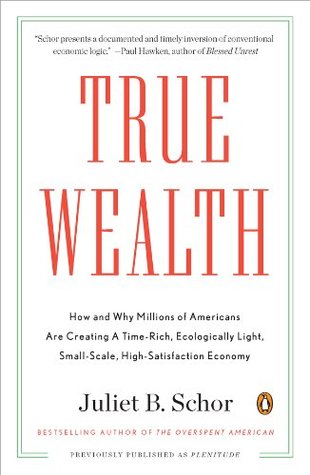More on this book
Kindle Notes & Highlights
But when income and wealth are so dramatically skewed toward the top as they currently are, and political power is also beholden to wealth, the private market approach produces what those with purchasing power want, rather than what the country or its people need. Standard theory ignores the distribution of purchasing power and comes to incorrect conclusions as a result.
In Europe, the mainstream political discourse in a number of countries has moved into figuring out to manage the post-growth transition, create alternatives to GDP, and achieve the shift to sustainable living.
But the mainstream conversation has been stalled by fatalism. We’re better at identifying what can’t be done than what we need to accomplish. There is a way forward, and I call it plenitude. The word calls attention to the inherent bounty of nature that we need to recover. It directs us to the chance to be rich in the things that matter to us most, and the wealth that is available in our relations with one another.
It puts ecological and social functioning at its core, but it is not a paradigm of sacrifice. To the contrary, it involves a way of life that will yield more well-being than sticking to business as usual, which has led both the natural and economic environments into decline.
These, then, are the individual principles of plenitude: work and spend less, create and connect more. In turn they yield ecological benefits—emit and degrade less—and human ones—enjoy and thrive more.
One reason the conversation reverted to its usual outlines is that macroeconomists, who focus on growth, employment, and the overall economy, have been slow to incorporate ecological data into their worldview.
Developments since the 2007 Intergovernmental Panel on Climate Change (IPCC) report, whose data ended in 2006, have been grim. Arctic sea ice was melting at hitherto unimaginable rates, and oceans were rising at more than double the IPCC report’s maximum possibility. Drought conditions were spreading. World emissions were sharply up in 2007, and in June 2008, James Hansen, NASA’s leading climate scientist, told Congress that the CO2 target “we have been aiming for is a disaster.” By February 2009, the news was worse, with scientists reporting that the speed of climate change was already beyond
...more
Yet it was as if the people charged with tending the economy were unaware of the breaking news on climate. The main conversation was about how to put more money into people’s hands and how to get them back to buying cars, any cars; building more houses, whatever their dimensions; and accumulating more stuff. The bailout and recovery efforts cost trillions, yet only 6 percent, or $52 billion, of the stimulus was actually “green.”
necessities. Interview research in late 2008 found a five-stage process that began with a “goodbye homo economicus” epiphany and continued through to a recalibration of what is important in life. People talked about a shift from an economy of “me” to an economy of “we,” from status-oriented spending to reengaging with the difference between needs and wants. The anthropologists who conducted the study were surprised to find this “larger, more existential debate.” But the public is aware that the American way of life is not sustainable. Surveys I worked on as early as 2004 found that more than
...more
If we can question consumerism, we’re no longer forced to make a mandatory choice between well-being and environment. If we can admit that full-time jobs need not require so many hours, it’ll be possible to slow down ecological degradation, address unemployment, and make time for family and community. If we can think about knowledge differently, we can expand social wealth far more rapidly. Stepping outside the “there is no alternative to business-as-usual” thinking that has been a straitjacket for years puts creative options into play. And it opens the doors to double and triple dividends:
...more
Some of the most important economic research in recent years shows that a single intervention—a community reclamation of a brownfield or planting on degraded agriculture land—can solve three problems. It regenerates an ecosystem, provides income for the restorers, and empowers people as civic actors. In dire straits on the economic and ecological fronts, we have little choice but to find a way forward that addresses both. That’s what plenitude offers.
A key prediction is that the days of sky-high market returns are over. The twin bubbles in finance and housing were a mirage. We now know that many of the gains were illusory, such as, for example, billions in fictitious profits in the financial sector. Rising prices for land, housing, and other assets were propelled by unrealistic valuations. The BAU economy is in for a long slide.
The first national study to assess the extent of the overstatement of growth was done for the 1970s and ’80s for Indonesia, and found that half its measured gross domestic product growth disappeared once timber, oil, and soil depletion was factored in.
The situation is even starker in China, where torrid growth has created environmental and social havoc. Studies of environmental degradation have found that Chinese GDP was overstated by 8 to 13 percent in the 1990s, and suggest the figure may have grown to as much as 25 percent now.
For the United States, we do not yet know how large the overstatement of market growth has been in recent years. In the early 1990s, the Bureau of Economic Analysis began work on a series of environmental accounts that would allow us to answer that question. But their efforts shortly ran afoul of the coal industry and Republican opposition, and Congress forbade the bureau to continue.


